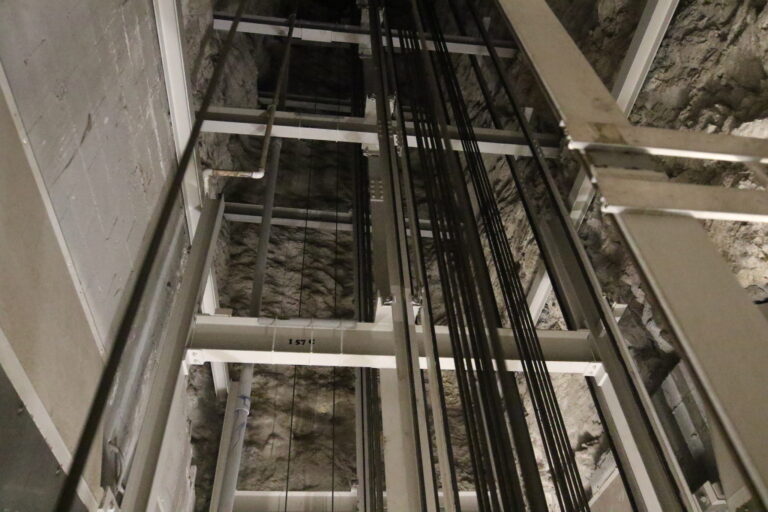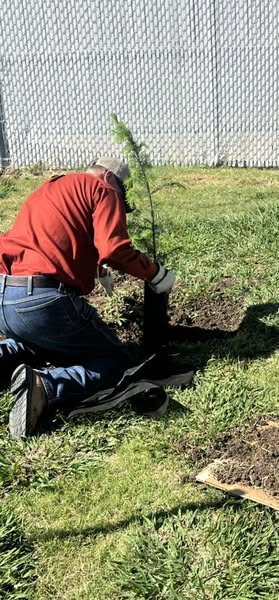Carlsbad Caverns rebuilds elevators, plans upgrades for second century of visitors

Story and photos by Adrian Hedden
El Rito Media
achedden@currentargus.com
A 752-foot ride into the underground via a one-stop elevator system to view the world-renowned rock formations at Carlsbad Caverns will be easier for visitors thanks to a $20 million project completed last year.
Carlsbad Caverns National Park, established in 1923 by then-President Calvin Coolidge is about 46,000 acres, and boasts 119 known caves. The park is situated about a 30-minute drive southwest of the city of Carlsbad amid the Guadalupe Mountains.
The most popular cave, and the one the park focuses on for daily visits, is the Big Room. It offers about a mile of lit underground walking trails, accessible to people with disabilities or who are wheelchair bound.
To get there, visitors can either hike down and up the extremely steep natural entrance or use the massive elevator system.
The system was first built in 1931 and has two sets of two cars: the 16-person primary elevators and the eight-person secondary elevators.
Before the elevators were installed, a wooden staircase painstakingly led visitors down into the cave.
In fall 2024, work to replace the secondary elevators was completed, meaning they can be used when the main elevators are down for maintenance. Those were rebuilt about six years ago, but require continual upkeep due to the unique environment in the cave, said Park Superintendent Carmen Chapin.
“One of the biggest challenges in this environment is the humidity,” Chapin said. “Things are extremely sensitive.”
The secondary elevators can also be used to move staff and equipment in and out of the cave without interrupting visitor trips that can number up to 60-80 a day, said Keenan Comer, operations chief at the park. They can also be used in busy times to alleviate congestion when the wait time to catch a ride back to the surface exceeds 15 to 20 minutes.
The rebuild included replacing structural steel in the shaft, after it became corroded and warped by the heavy moisture. Along with rebuilding the cars and adding digital screens, the project also added new lighting.
‘A huge expense’
The cars travel about eight feet per second, Comer said, and about 33 miles a day.
Over the decades, the wear and tear of all those rides meant the park service replaced and refurbished individual components of the elevators as needed, Comer said. The recent projects were the first the time the systems were completely rebuilt.
“It had to do with cost,” he said. “It was a huge expense, and that’s taxpayer money. When our visitors come in here, it’s their money at work. It’s all brand new.”
Rebuilding the elevators was part of a park-wide infrastructure overhaul. Last year, Chapin said, the park service requested about $30 million in federal funds for deferred maintenance, or projects such as infrastructure that were delayed because leaving them unfinished would not immediately interrupt park operations.
The elevator modernization project was mostly funded through the 2020 Great American Outdoors Act, which sent about $40 million to the park for several infrastructure projects including modernizing the secondary lifts. A total of $1.9 billion was allocated to the National Park Service via the Outdoors Act.
Deferred maintenance projects require funding from Congress, Chapin said, as they would be unachievable with the park’s annual budget of about $9 million.
“When you get those big-ticket projects, it’s not something that would come out of the park’s budget,” she said.
But the work still needed to get done, she said, especially as Carlsbad Caverns celebrated its 100th anniversary on Oct. 23, 2023.
“There is infrastructure that is still here from the 1930s,” Comer said. “We have a lot of projects going on.”
The projects include new water and sewer lines tying into the lines within the park’s historic area where housing for staff is located alongside decades-old structures. The park also plans to restore its underground lighting system, which includes 10 miles of power lines in the underground, and add electric vehicle charging stations for park service vehicles.
Airlock nearing completion
A project was underway to install a series of airlocks at the bottom of the elevator shafts, serving as the entryway in and out of the cavern to prevent the release of radon on the surface after it was detected in the air of the Visitor Center in 2018.
That should be completed by early 2025.
Radon is an odorless, colorless and tasteless gas that results from the gradual decay of uranium in rocks and soil. Breathing in high levels of radon over a long period of time can lead to lung cancer and other health impacts.
Levels in the Big Room and Visitors Center are “very, very low,” Chapin said, but were high enough in deeper, less accessible areas of the cave system such as the Spider or Lechuguilla caves to see those areas closed temporarily.
How the airlock works: Once exiting the elevator, visitors walk through a door into a lobby area. A second door from the lobby into the cave cannot open until the first door is securely closed.
This prevents radon from escaping into the elevator and traveling to the surface, potentially exposing visitors and staff to higher levels over time. The possibility of radon exposure is also why staff is limited in how much time they can spend in the cave – 40 hours a week in winter and 30 hours a week in summer when radon levels are higher, Comer said.
“The only thing you can do is monitor it and manage your time,” he said of the radon.
The airlocks also prevent moisture from escaping the cavern, which can cause pools of water in the cave to dry up and impact underground species of plants and animals.
“The elevator shafts act like huge chimneys,” Chapin said. “Even when they are slightly cracked, we lose a lot.”



